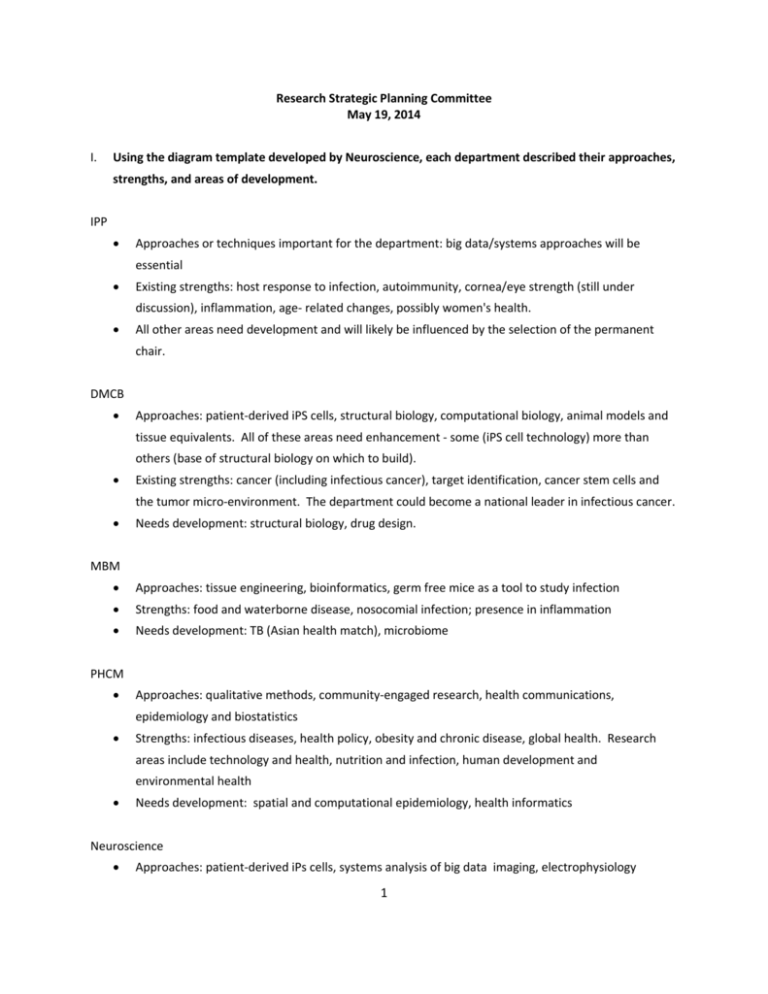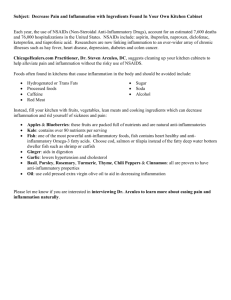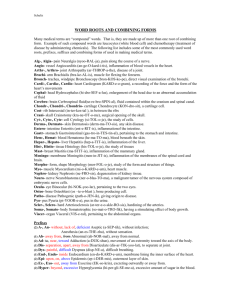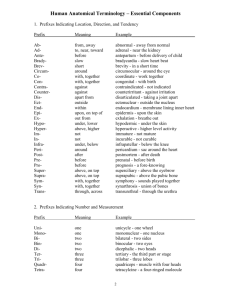Research Strategic Planning Committee
advertisement

Research Strategic Planning Committee May 19, 2014 I. Using the diagram template developed by Neuroscience, each department described their approaches, strengths, and areas of development. IPP Approaches or techniques important for the department: big data/systems approaches will be essential Existing strengths: host response to infection, autoimmunity, cornea/eye strength (still under discussion), inflammation, age- related changes, possibly women's health. All other areas need development and will likely be influenced by the selection of the permanent chair. DMCB Approaches: patient-derived iPS cells, structural biology, computational biology, animal models and tissue equivalents. All of these areas need enhancement - some (iPS cell technology) more than others (base of structural biology on which to build). Existing strengths: cancer (including infectious cancer), target identification, cancer stem cells and the tumor micro-environment. The department could become a national leader in infectious cancer. Needs development: structural biology, drug design. MBM Approaches: tissue engineering, bioinformatics, germ free mice as a tool to study infection Strengths: food and waterborne disease, nosocomial infection; presence in inflammation Needs development: TB (Asian health match), microbiome PHCM Approaches: qualitative methods, community-engaged research, health communications, epidemiology and biostatistics Strengths: infectious diseases, health policy, obesity and chronic disease, global health. Research areas include technology and health, nutrition and infection, human development and environmental health Needs development: spatial and computational epidemiology, health informatics Neuroscience Approaches: patient-derived iPs cells, systems analysis of big data imaging, electrophysiology 1 Strengths: autism, epilepsy, obesity, neurodegeneration. Glial-neural interactions and glutamatergic and GABAergic synaptic transmission are research areas. Need development: neuro-inflammation, and the two approaches listed above II. Departmental intersection on inflammation, arc of life/human development, Asian health The table below describes the intersection of themes discussed with cross-departmental opportunities that interlace with department-specific priorities. Inflammation Arc of life Asian health DMCB IPP MBM PHCM Neuroscience X Development biologists – pediatric cancers, young adult cancers and cancer in aging populations Cancer with focus on tumors prevalent in the Asian population X Inflammation as a progressive condition associated with age X Age-related susceptibility to different infectious diseases X X Autism, epilepsy and neurodegeneration TB and food and waterborne diseases Community based research III. Proposal for Themes The group discussed a way of framing research priorities that would encompass the approaches and needs that have evolved during the planning process. Thinking about an overarching theme, such as Improving the Quality of Life, was thought to be one possible organizing principle. 1. What: Inflammation is the unifying biological mechanism that could be a hub for multi-disciplinary research in all five departments. Research in inflammation can be conceived as a biomedical question centered on mechanisms that bring researchers working on a range of diseases that involve inflammatory processes. Such diseases include most chronic diseases of health importance. Some thought must be devoted to conceptualizing inflammation in a way that is understandable to the broader community and attractive to donors. 2. Who: Touching individuals across the arc of life is an idea that is consistent with the inflammation concept and expands upon it. This idea also has the potential to encompass personalized medicine, which is a much broader concept and perhaps beyond the scope of the current planning effort.. 3. Where: One population of interest is the community in which we reside. Embedded in the third largest Chinatown in the US, TUSM has an opportunity to affect these individuals. The migratory patterns that bring populations to Chinatown, community-based studies and using health communication research are all areas in which TUSM can make an impact. Asian health incorporates diseases such as TB, some types of cancer, and how the environment affects a variety of chronic disease states. This area is ripe for collaboration between TUSM, the HNRCA and Tufts Medical Center. 2 4. How: Bioinformatics to manipulate big data so that cutting edge methodologies can be employed to underpin research efforts. Big data, computation and systems analysis are needs shared by all departments. Areas of interest include a variety of state-of-the-art technologies, some of which are more important for certain faculty groups than others.. For example, analysis of big data sets is an important component for working on the microbiome while for PHCM, valuable social demographic and clinical data could be mined from Medicare with the appropriate faculty expertise. Faculty recruitment is sometimes compromised because we lack these resources. The group felt that TUSM should have a bioinformatics core program and that we must recruit faculty who have original research that relies on big data. This idea stems from the fact that faculty actively engaged in research in an area drive technology forward in ways that cannot always be accomplished by individuals who staff a core. Some research would be dry and some wet. PHCM could serve as the home for both the core and faculty, although some faculty might be appointed in the departments. Other cores that need to be developed or resourced to study diseases and disease processes are onsite animal models, metabolomics, imaging, tissue engineering, and development of iPS cells. The group was extremely sensitive to the idea that certain resources needed to be on-site but that resources available elsewhere related to materials that could be "shipped" outside should not be duplicated on-site. 3







